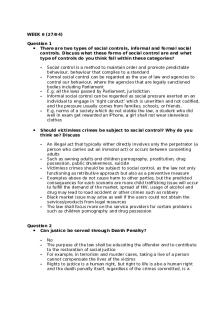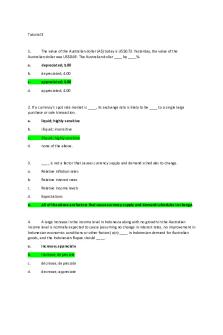Tutorial 3 ACC2200 PDF

| Title | Tutorial 3 ACC2200 |
|---|---|
| Author | Ivan LI |
| Course | Introduction to Management Accounting |
| Institution | Monash University |
| Pages | 3 |
| File Size | 102.8 KB |
| File Type | |
| Total Downloads | 7 |
| Total Views | 143 |
Summary
Tutorial 3 homework questions...
Description
2.5) What is meant by the phrase, “different costs for different purposes”? In management accounting, the principle that the management of an organization is likely to need different information, and thus different costs, for the various activities it carries out, especially when making decisions. For example, when calculating the price of a product on a cost-plus basis, management would need to ensure that all costs, both fixed and variable, are charged to the product. On the other hand, in determining whether or not additional units of a product should be produced, only the variable costs would be relevant to that decision. Based on different costs of information or usages, managers will have to consider various purposes, First purpose, decision making to identify relevant costs for decision of project on hand, Second purpose, evaluation of long-term profitability by having assessment on full costs of performance object, Third purpose, to plan the future by comparing planned and actual costs Fourth purpose, to value inventories and cost of goods sold for the input of financial accounting 2.6) Traditional management accounting systems classify costs as fixed and variable. Define these terms and provide three examples of each for a bank. Fixed Costs are costs that don't vary depending on the amount of work a company is doing. These are usually things like the payment on a building, or a piece of equipment that is depreciating at a fixed monthly rate. Other e.g. Salaries. This is a fixed compensation amount paid to employees, irrespective of their hours worked. Utilities. This is the cost of electricity, gas, phones, and so forth. These costs have a variable element, but is largely fixed. Interest expense. This is the cost of funds loaned to a business by a lender. This is only a fixed cost if a fixed interest rate was incorporated into the loan agreement. Variable costs are cost changes, in total, in direct proportion to a change in the level of activity. Examples are like repair and maintenance costs on machines, office supply costs and bank charges.
2.7) When analysing cost behaviour, what do we mean by “level of activity”? The way a specific cost reacts to changes in activity levels is called cost behaviour. Costs may stay the same or may change proportionately in response to a change in activity. Knowing how a cost reacts to a change in the level of activity makes it easier to create a budget, prepare a forecast, determine how much profit a new product will generate, and which of two alternatives should be selected from. From the word itself, “level of activity” refers to the level of work performed in a business, and the activity causes the cost to be incurred, which is useful in planning and managing production cost when analysing and understanding the cost behaviour.
2.22) Traceability and controllability when considering what costs incurred Relevant range of level of activity So, a period cost cannot be manufacturing OH, and it must be non-manufacturing cost If the cost is product cost then it is manufacturing cost Whether the cost within the production or not Overhead is a period cost Upstream is product cost whereas Downstream is period cost 1. Advertising costs of Nike - period, fixed costs, non-manufacturing cost * usually with a contract, if in a case the advertising costs is counting per pages or copies it can be a variable costs 2. Straight-line depreciation on mining machinery of BHP Billiton - product (depreciation on machinery output), fixed costs, manufacturing overhead (MOH) 3. Wages of assembly line personnel of Mack Trucks - product, variable, direct labour manufacturing, fixed cost assembly line usually be working for fixed hours 4. Delivery costs on customer shipments of Street ice-cream - period, variable costs, non-manufacturing cost (after the shipment) 5. product, variable, direct material manufacturing 6. product, fixed, MOH, plant (factory related) for manufactured Machinery 7. product, variable, direct material MOH 8. product, variable, direct material MOH 9. period, variable costs, non-manufacturing 10. product, variable, MOH, wood glue need to realise how significant it is, however it’s not worthwhile to trace back. 11. product, variable, MOH, as the refinery security guards are factory related 12. period, fixed costs, non-manufacturing
Problem: 2.33) Costs
Product/Period
Q1 Q2 Q3 Q4 Q5 Q6 Q7 Q8 Q9 Q10 Q11
Product Product Period Period Product Product Product Period Product Period Product
Conversion
Prime
Direct Labour/ Direct Material/ Manufacturing Overhead
Prime Cost
Direct Material
Prime Cost Prime Cost
Conversion Cost
Direct Labour Direct Material MOH
Conversion Cost
MOH
Conversion Cost
MOH
Conversion Cost...
Similar Free PDFs

Tutorial 3 ACC2200
- 3 Pages

Tutorial 3
- 3 Pages

Tutorial 3
- 4 Pages

Tutorial 3
- 4 Pages

Tutorial 3
- 12 Pages

3 - tutorial
- 6 Pages

Tutorial 3
- 6 Pages

Tutorial 3
- 4 Pages

Tutorial 3 - Lecture notes 3
- 5 Pages

Tutorial 3 Answers
- 4 Pages

Tutorial 3 Solutions - EC202
- 4 Pages

Tutorial 3 Solution - investment
- 3 Pages

Tutorial 3 - ccc
- 1 Pages

Tutorial work - 1 - 3
- 31 Pages

Tutorial 3 - Answers
- 6 Pages

OD tutorial 3
- 5 Pages
Popular Institutions
- Tinajero National High School - Annex
- Politeknik Caltex Riau
- Yokohama City University
- SGT University
- University of Al-Qadisiyah
- Divine Word College of Vigan
- Techniek College Rotterdam
- Universidade de Santiago
- Universiti Teknologi MARA Cawangan Johor Kampus Pasir Gudang
- Poltekkes Kemenkes Yogyakarta
- Baguio City National High School
- Colegio san marcos
- preparatoria uno
- Centro de Bachillerato Tecnológico Industrial y de Servicios No. 107
- Dalian Maritime University
- Quang Trung Secondary School
- Colegio Tecnológico en Informática
- Corporación Regional de Educación Superior
- Grupo CEDVA
- Dar Al Uloom University
- Centro de Estudios Preuniversitarios de la Universidad Nacional de Ingeniería
- 上智大学
- Aakash International School, Nuna Majara
- San Felipe Neri Catholic School
- Kang Chiao International School - New Taipei City
- Misamis Occidental National High School
- Institución Educativa Escuela Normal Juan Ladrilleros
- Kolehiyo ng Pantukan
- Batanes State College
- Instituto Continental
- Sekolah Menengah Kejuruan Kesehatan Kaltara (Tarakan)
- Colegio de La Inmaculada Concepcion - Cebu